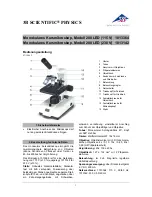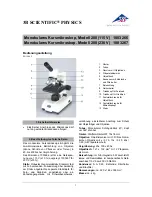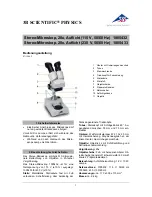
12
27. Measuring cup
28. Hatchery
1. What is a microscope?
A microscope contains two lens systems: the eyepiece and the objective.
We’re presenting these systems as one lens each so that the concept is
easier to understand. In reality, however, the eyepiece (1) and the objective
in the turret (3) are made up of multiple lenses.
The lower lens (objective) produces a magnified image of the prepared
specimen. The picture, which you can’t see, is magnified once more by the
second lens (eyepiece, 1), which you can see as the ‘microscope picture’.
2. Assembly and location
Before you start, choose an ideal location for using your microscope. It’s
important that you choose a spot with enough light for normal observation.
Furthermore, it is recommended that you place the microscope on a stable
surface, because a shaky surface will not lead to satisfactory results.
3. Normal observation
For normal observation, place the microscope in a bright location (near
a window or desk lamp, for example). Turn the focus knob (2) to the up-
per stop, and set the objective turret (3) to the lowest magnification.
Now, turn on the light using the switch on the microscope base. You’ll find
further tips about the light source in the next section. Now, place a pre-
pared slide under the clips on the stage (4), directly under the objective
(1). When you take a look through the eyepiece, you can see the magni-
fied specimen. At this point, you still might see a slightly fuzzy picture.
Adjust the image sharpness by slowly turning the focus knob (2). You
can now select a higher magnification by turning the objective turret and
selecting a different objective.
When you do so, note that the sharpness of the picture must be adjusted
again for the higher magnification. Also, the higher the magnification,
the more light you will need for good illumination of the picture. The
wheel with pinhole apertures (9) below the microscope stage (4) will
help you in viewing very bright or clear-sighted preparations. Turn the
wheel (9) till the best contrast is achieved.
4. Observation (electronic light source)
For observation with the electronic light source (6) you need to insert
2 AA batteries 1.5 V, in the battery compartment (8) on the base of the
microscope (7). The battery compartment is opened using a Phillips
screwdriver. Insert the batteries with the correct polarity (+/- indication).
Put the battery cover first into the small opening so that the lid fits per
-













































